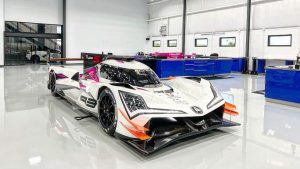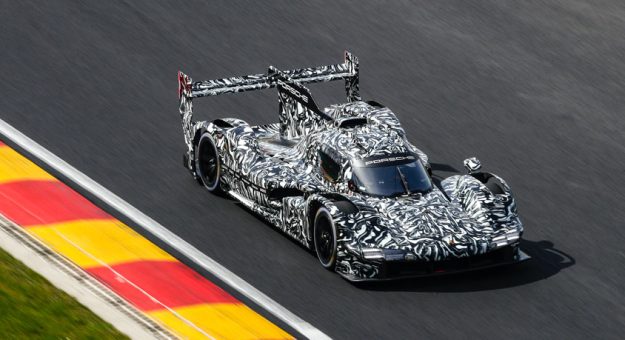A new prototype rules formula is expected to strengthen the top class of the IMSA WeatherTech SportsCar Championship with multiple manufacturers set to contest the new LMDh regulations for the new GTP class.
LMDh (Le Mans, Daytona and h being undefined per IMSA) is the car build, similar to LMH (Le Mans Hypercar) for the World Endurance Championship. IMSA rules specify that an LMDh manufacturer designs and builds a car around a tub supplied by one of four LMP2-approved manufacturers — Oreca, Dallara, Multimatic and Ligier.
All cars will use a spec hybrid system in conjunction with an internal combustion engine. The cars will weigh a minimum of 1,030 kilograms, or just more than 2,270 pounds.
Manufacturers building cars to the LMH regulations for the FIA WEC will be allowed to bring those cars over to compete in IMSA’s GTP class. Conversely, cars built to LMDh regulations will be allowed to race in the Hypercar class of the FIA WEC, even if they aren’t planning on competing in IMSA full time.
Alpine is one such example. The French manufacturer announced plans to compete with two Oreca-based prototypes built to LMDh regulations in the FIA WEC starting in 2024.
Lamborghini has partnered with Ligier for a 2024 full-season entry in both IMSA and the FIA World Endurance Championship. BMW enlisted Dallara as a partner for its two-car entry for 2023 and has been mum regarding testing and development of the new car.
Porsche will be running four Multimatic-based cars, named the 963 as a successor to the 956 and 962 prototypes of the 1980s and 1990s. Roger Penske’s team will campaign two 963 machines in IMSA and two more in the FIA WEC, continuing a relationship with Porsche dating back to the 1950s.
JDC-Miller Motorsports will run one 963 machine as a privateer customer entry with a yet-to-be-announced team fielding the final entry in IMSA.
The 963 was the first LMDh car to test. Porsche factory driver Frédéric Makowiecki drove the car in its first outing in mid-January 2022 around the Porsche factory test track in Weissach, Germany. Since then, the car has completed thousands of miles on European and American tracks.
Jonathan Diuguid is the managing director of Team Penske’s sports car program.
He stated with the team when Penske competed with Porsche LMP2 cars in the American Le Mans Series. Diuguid worked on the Penske ran Acura IMSA program and acknowledged the differences between this generation of prototypes compared to the Acura he helped manage from 2018-’20.
“As we step into the LMDh and GTP platform, the level of complexity goes up quite significantly with the hybrid system,” Diuguid said. “I think there’s a lot of advantage with the power train that’s in the car, but there’s also a lot of extra effort to make the hybrid system work with the internal combustion engine to work with traction control, how the gearbox shifts and all these different things that have to work together and perform at the same level of this previous generational of prototypes, which has sort of evolved over the course of 15 or 20 years. I would say this is definitely an evolution in prototypes and a huge step compared to all the previous ones.”
Team Penske has been running an LMP2 prototype car in the FIA World Endurance Championship with Dane Cameron being one of the lead drivers in the Oreca car. Cameron drove for Team Penske for all three seasons of its Acura DPi program, winning the class championship with Juan Pablo Montoya in 2019.
Cameron also drove the new 963 in testing at Sebring (Fla.) Int’l Raceway and noted how different the 963 handles compared to the DPi machines.
“The car drives differently, makes a lot of time differently, but at the end of the day it’s still a prototype sports car, race car,” Cameron said. “It has a lot of the same sort of traits. We have more horsepower now with this new category that’s coming, so that’s pretty fun. Drivers never complain about having a bit more horsepower, but with the hybrid components and batteries and these things, the weight of the car has gone up, so they’re a bit heavier.
“It doesn’t quite feel as small and nimble as the DPI car does. The cars I think are growing as well in the dimensions so they feel a little bit bigger, a little heavier,” Cameron added. “Also by regulations, you have a little less downforce now, so a little slower in some of the really, really high-speed corners. But again, we have more horsepower, so you make the lap time a little bit differently across the lap. But overall it’s still a prototype car, still fun to drive.”

If Porsche finds any failures in the spec hybrid components, they report that information to IMSA. That information will benefit the other LMDh manufacturers that don’t have as much track time, such as Cadillac. The General Motors brand started testing its Dallara-based Cadillac V-LMDh machine in early July.
GM sports car racing manager Laura Wontrop Klauser was pleased with how quickly the new car was able to get into the preliminary testing program.
“Our shakedown that we had with the first car was a huge success,” Klauser said. “We were able to not only just run what you consider a normal shakedown, get it out and literally shake the car down, find out what’s fitting together correctly and what’s not. We got past that quickly and went right into testing with that first run, which was great.
“I mean from the programs that I’ve dealt with, that’s not normal. Usually, that first run that you’re out there, there’s a lot of things you’re still working through and you’re usually plugged into the car for a good half day to three quarters of a day when you get there trying to work through all that. And this one, we were able to pretty much fire up and go.”
Cadillac had one complete car assembled for initial testing, with two more cars that were close to completion as of press time. Those cars were still missing a few critical components that are necessary for testing. Cadillac officials are pleased with their progress despite limited track time with one car, but are always concerned about what happens if a car has an incident.
“We’ve had to think about that when we’ve set up our testing schedule,” Klauser said. “You want to break things, that’s what testing’s all about. You’re trying to find the weak points and then make them better. But there are some things if we break, we will not get another one until maybe just before the (Rolex 24) if we’re lucky. So those are where we have to be strategic. How far do we push something?
“And we’re doing that in conjunction with the suppliers, because they understand the situation that we’re in and they too want to learn,” Klauser said. “They want to know how things are working, but they can’t ask any of us to break something and then not be able to replace it. So we have to work together to see what’s the right way to balance all the risk for everything, but still be able to figure out what we need to know. And I feel like just this type of learning is just going to carry forward even after we start racing because of all these limitations we’ve had with part availability.”
Three Cadillac V-LMDh machines will race in IMSA in 2023, with Action Express Racing entering one car and Chip Ganassi Racing entering two cars. The V-LMDh will also compete in the FIA WEC.
Acura is the final manufacturer slated to compete next season and they will continue with their current teams. Wayne Taylor Racing and Meyer Shank Racing will each compete with one new car, designated the ARX-06.
Honda Performance Development put the AR24e engine and the rest of the powertrain components (Bosch hybrid Motor Generator Unit and gearbox) on their California-based dyno in 12- and 24-hour tests where accelerating, braking and shifting are simulated on the programmed circuit in the software while the testing program was getting underway.
The first ARX-06 had an initial shakedown test at Circuit Paul Ricard, mainly due to the circuit’s extremely close proximity to the Oreca factory. There was a two-day test at the Magny-Cours circuit that hosted the French Grand Prix, mainly because the track allowed testing at night.
The car’s first laps in the U.S. were at the Kansas Speedway road course.
With many manufacturers crossing over from series to series, next season looks to be the start of a new golden age in sports car racing across the globe, and it all starts at the Rolex 24 in January.
